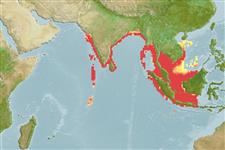Classification / Names
Common names from other countries
Main reference
Size / Weight / Age
Max length : 94.0 cm FL male/unsexed; (Ref. 168); 98.0 cm (female); common length : 70.0 cm FL male/unsexed; (Ref. 9684)
Length at first maturity
Lm 70.0 range ? - ? cm
Environment
Marine; pelagic-neritic; oceanodromous (Ref. 51243)
Climate / Range
Tropical, preferred 28°C (Ref. 107945); 24°N - 11°S, 70°E - 115°E (Ref. 168)
Distribution
Short description
Dorsal
spines
(total): 15 - 18;
Dorsal
soft rays
(total): 15-19;
Anal
soft rays: 17 - 22;
Vertebrae: 44 - 46. A unique pigment pattern of short lines on the sides which distinguishes from all other species of Scomberomorus; maxilla with the posterior end greatly expanded; parasphenoid wide (Ref. 10996). Interpelvic process small and bifid. Lateral line without auxiliary branches anteriorly, running almost straight below second dorsal finlet then slightly bent downward toward keel of caudal peduncle. Intestine with 2 folds and 3 limbs. Swim bladder absent. Body covered with small scales. First dorsal fin black posteriorly.
IUCN Red List Status (Ref. 115185)
Threat to humans
Harmless
Human uses
Fisheries: commercial; gamefish: yes
More information
ReferencesAquacultureAquaculture profileStrainsGeneticsAllele frequenciesHeritabilityDiseasesProcessingMass conversion
Tools
Special reports
Download XML
Internet sources
Estimates of some properties based on models
Phylogenetic diversity index
PD50 = 0.5000 many relatives (e.g. carps) 0.5 - 2.0 few relatives (e.g. lungfishes)
Trophic Level
4.5 ±0.80 se; Based on food items.
Resilience
Medium, minimum population doubling time 1.4 - 4.4 years (K=0.18-0.22; tm=2; Fec=560,000)
Vulnerability
Moderate to high vulnerability (49 of 100)
Price category
